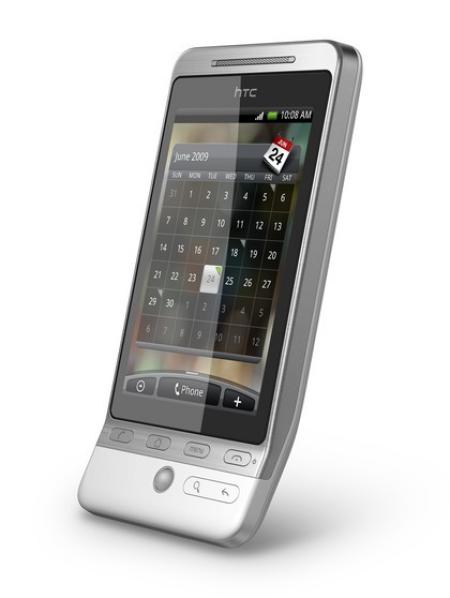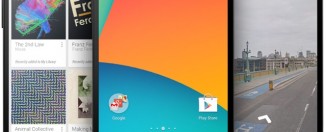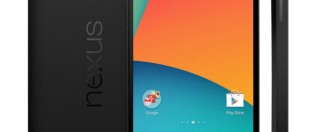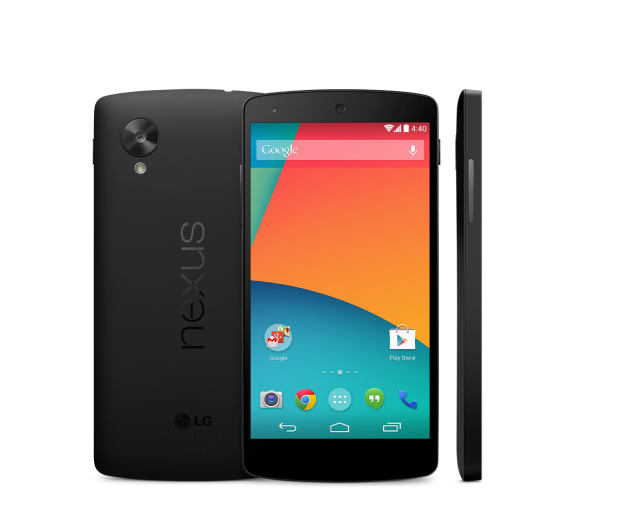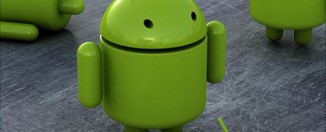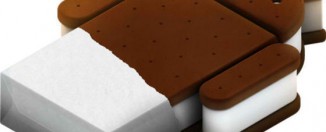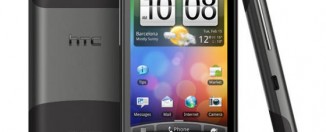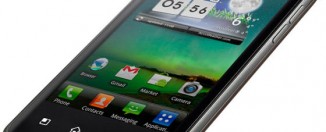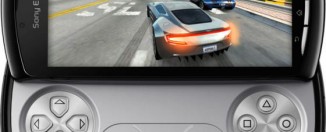HTC Hero Review – nearly almost the perfect Android
Time, at last, for an HTC Hero Review round-up. After working feverishly on the new look MobileMentalism for what seems like the past 100 years (still not finished – give me time, people, it’ll be worth the wait ;), I remembered that I said I’d do a review of HTC’s brand new Android phone, the Hero. So here it is!
For those who don’t know, the Hero is the latest Android phone from HTC, who’ve so far not only taken the lead, but seemingly cornered the market in Android phones. The Hero has been long awaited by tech lovers as its the first Android phone with a heavily-customized user interface and might, just might, actually beat the iPhone in terms of overall user interface.
So the question is: does it? Read on to find out!
HTC Hero from the outside
You can tell the Hero’s an Android phone from HTC as soon as you look it. The chin, the end of the phone that curves up at an angle of 30 degrees, is a dead giveaway, as it’s featured on all of HTC’s phones so far.
However, the Hero is just a little bit more special than its older siblings, the G1 and the Magic. Its far more solid, for example, being made of better materials; its screen is much more vivid, being on a par with the iPhone’s; and the white version is quite literally teflon coated, meaning it won’t scratch, and it’s unlikely to burst into a billion bits when you drop it!
Actually, all Androids seem quite robust, at least if my G1 is anything to go by. I’ve dropped it quite a few times, and although heart stopped on each occasion, the G1 didn’t – no damage whatsoever! This bodes well for the Hero’s sturdiness.
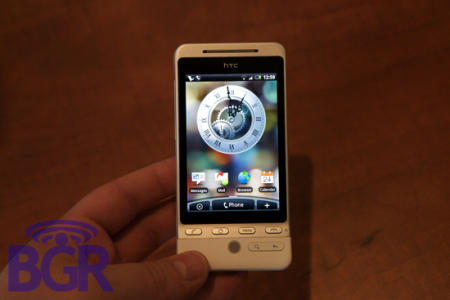
Controls, buttons and ports
The Hero comes with six buttons on its front, which is a break from the normal touchscreen phoen convention of having as few as possible.
On the Hero’s chin (as it were!) sits the Home, Back, Menu and End buttons, as you’d expect, as well as Send and Search keys. There’s also a trackball, as you’d expect from an HTC Android phone.
Hopefully, this’ll be the limit of buttons on the exterior, as the whole point of a touchscreen is that you don’t need any!
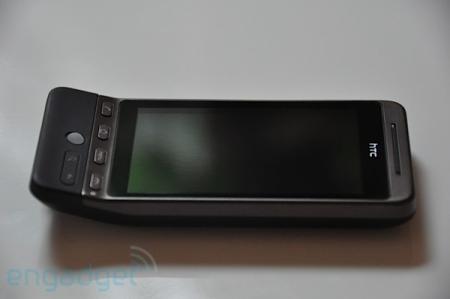
That said, the reasoning behind the search button is pretty sound. Android is, after all, a Google OS, and Google likes its search. The latest version of the Android OS, called Donut, will apparently feature search integrated tightly throughout the entire OS. Having a dedicated button that lets you search for anything anywhere on either your phone, your location or across the Web, will be a real time saver.
There’s a also a volume switch on the side of the phone, and a 3.5mm headphone jack.
The Screen
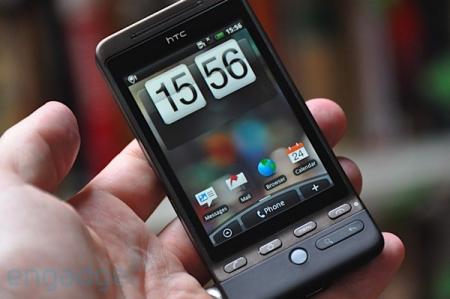
The Hero’s screen is the best screen yet seen on an Android phone. It’s a responsive 3.2-inch capacitive touchscreen that runs at 320×480 HVGA resolution with crystal clear colours and contrast.
Some phones make you want to buy them just from the quality of the screen alone. The HTC Hero is one of those phones.
HTC Hero’s Features
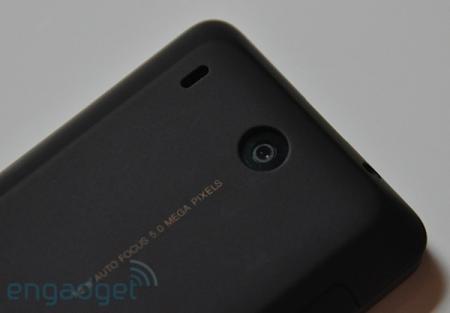
It used to be the case when reviewing phones that I’d dive into the phone’s features, excitedly reeling them off and thinking up ways that you could use, say, GPS on your phone.
This kind of peaked with the Nokia N95, which came with so many features, it was hard to think of what else you could add to a phone.
Indeed, it wasn’t just hard for review writers – it was hard for Nokia and other manufacturers as well, as virtually every device since then has offered more or less the same set of features, just with better results.
As such, the features on a phone in 2009 matter far less than the overall user experience, which I’ll come to shortly.
Before I do, I’ll just list the features of the Hero:
- 5 megapixel camera
- Video recording (only 352×288 resolution)
- GPS
- HSDPA
- Wi-Fi
- Webkit-based browser with Flash support
- MP3 player
- Video player
- More sensors than you’d ever find use for!
Anything there you weren’t expecting? A couple of things of note: firstly, the 5 megapixel camera, which actually turns out some good pics, although there’s no flash with it; and the inclusion of Adobe’s Flash, which is something people have been screaming out for for ages now.
The Hero isn’t just the first smartphone to have Flash – it’s the only smartphone to have it (at least at the moment), so kudos to HTC for getting in there first.
One thing worth noting – there’s no physical keyboard. Like the iPhone and HTC Magic before it, the HTC Hero relies on a virtual keyboard. I’m not a fan of these, and although HTC has done a good job in terms of making a virtual keyboard that’s better than the stock Android version, it’s still not great, and is nowhere near as good as a physical keyboard.
It’s good enough for text messages and browsing the Web with, but you wouldn’t want to write lengthy emails or blog posts with it.
Music Player and Video player
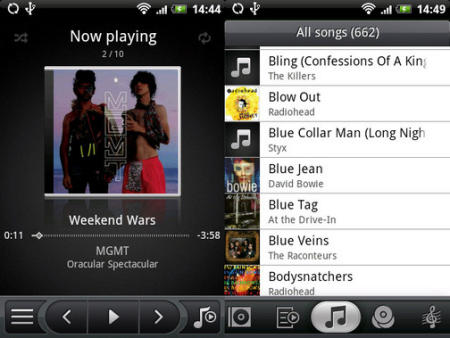
The Hero, naturally, comes with a music and video player. Neither are quite as polished as the iPhone’s, but they are extremely good, featuring easy to use navigation and more user interface polish.
Both MP3 player and video player look much better than they do on other Android devices thanks to the new user interface that HTC has created especially for the Hero.
As far as sound is concerned, the speaker quality isn’t bad, but with a 3.5mm headphone jack thoughtfully included, you can listen to it in much greater quality with a decent set of bins.
HTC hero’s user experience
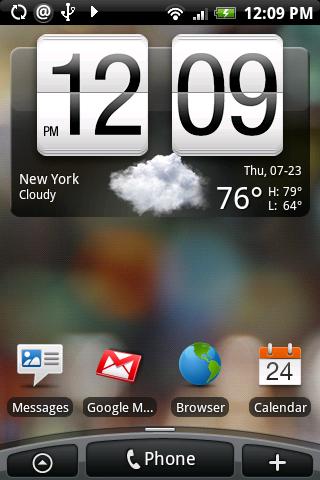
Right, can I talk about the user experience now? Good!
Ever since the iPhone was released, user experience became the only thing worth focusing on when discussing smartphones. Because their hardware features are so similar, the only thing to differentiate them now is their software. In particular:
- The user interface – how good does it look and how responsive is it?
- Mobile web integration – how connected is the phone to the mobile Web?
- Apps – how many third party apps are there and how well do they work?
- Mobility and location – it’s a mobile device that knows where it is – how well can it take advantage of that fact?
The iPhone scores highly in all these areas, as it should, as it was the first phone to really focus on them. As it’s the current best-seller for touchscreen smartphones, this is the benchmark the Hero has to beat.
And note that it’s only the sales of the iPhone that makes it the benchmark. I’m not an iPhone fanboy – if the Nokia N97 was the best-seller, then this would be the benchmark I’d set. But it’s not, and the iPhone is, so I’ll stick with the iPhone!
Equally, the Hero has to at least match the Palm Pre and better the previous HTC Android phones if it’s to come out with a good result.
So does it?
HTC Hero User Interface
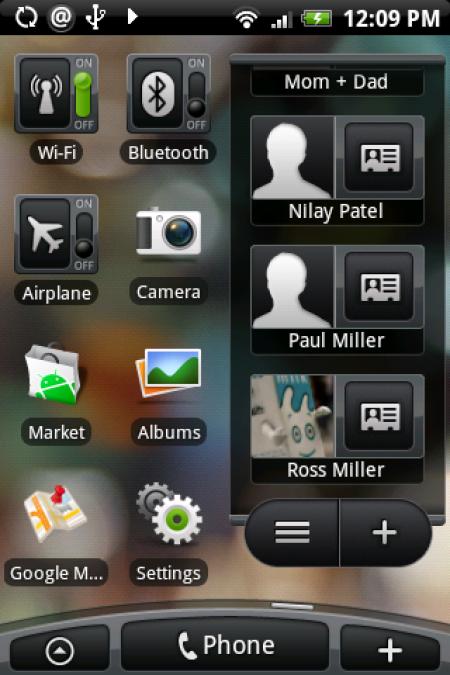
In terms of looks, the HTC Hero is simply gorgeous. As good as, if not better than, the iPhone and Palm Pre, the Hero has been endowed with so much chrome and polish by HTC that it’s leagues apart from its other Android phones.
The Hero shows what Android is truly capable of, and sends a shot across the bows of Apple in particular. If Android can look this good now, less than a year after the release of then first model, how good will it look next year or the year after, when dozens of models from all the big players have been released? Sure whets the appetite just thinking about it!
HTC have taken Google’s original Android UI and embellished it with extra polish, nice gradients, lovely alpha transparencies and an overall look and feel that makes the Hero feel like a quality smartphone.
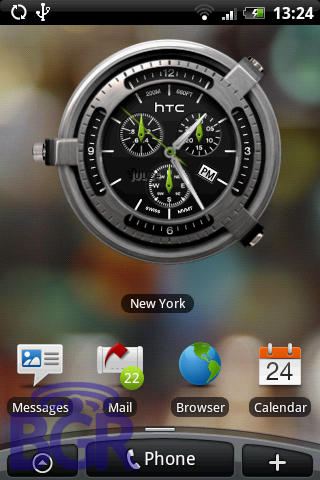
There are brand new widgets for the homescreen, including beautiful clocks and weather widgets, and social media apps such as Twitter, Flickr and Facebook have been tightly integrated into the UI, which pulls in data from these apps (such as status updates and photos) and inserts them at appropriate points throughout the phone so you can always see what your friends are up to (and what they look like – you know, just in case you forget!).
The end result is a beautiful looking UI that gives you easy access to your social media world, making the overall user experience a really really good one.
In fact, the UI, called the Sense Experience (or “Rosie”, as it was codenamed), is gorgeous, and almost makes you want to buy the Hero based on looks alone.
Almost! Unfortunately, the addition of all that gloss comes at a cost – speed. The Hero uses the same hardware as the HTC Magic (a Qualcomm 528MHz CPU, 288MB of RAM and 512MB of ROM), which is fine for the original Android UI, but is noticeably slower when pushing the Hero’s UI round.
It’s not a huge deal – but it is annoying, and it sets the Hero’s overall score down a notch.
How the Hero compares to previous Android phones, though, is a tough one to call. It looks leagues better, but it’s is a bit slower. Would that put you off buying it? Best check it out in the flesh before you buy it to see if it’s too slow for your own preferences.
Mobile Web Integration
Android Web Browsing
The Android OS used by the Hero is tightly coupled to the mobile Web. Indeed, the whole point of Google creating Android is to get more people using the mobile Web so they can grow their advertising market. As such, the Web is infused everywhere throughout all Android phones.
Google’s Calendar (now with a nice new look), Maps, GMail and search, are all available, and pictures of your contacts are pulled straight from Facebook.
The Webkit browser is great to use, the touchscreen really helping as you slide the Web page around the screen with your finger.
In fact, Android makes browsing the Web so effortless that I now start the day reading my Twitter updates on my phone before I read my email. I browse any interesting links that have been tweeted, and save them on Delicious or ReadItLater if I need to, well, read them later (!), all without even noticing that I’m using the mobile Web. It really is that seamless.
Hero Web browsing
With the Hero, using the mobile Web has been notably improved thanks to multitouch support for pinch-zooming as well as Flash playback.
Yup, that’s right – the Hero has multitouch, and about time too! With the browser, it works just as well as the iPhone, and makes the Nokia N97 seem even more outdated.
The Hero also offers better overall browsing as the browser has been tweaked with new transitions that enable you to scroll back and forward between pages you’ve viewed in a much more elegant way.
Social Media integration
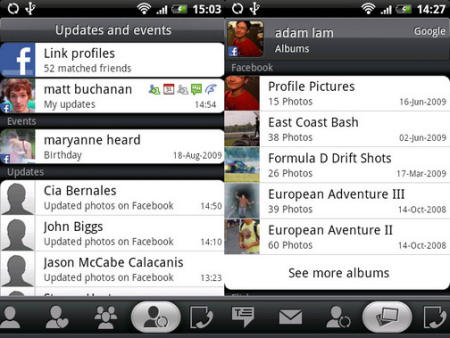
In addition to seamless mobile Web integration, the Hero also couples tightly with social media sites like Facebook, Twitter and Flickr. Android phones already do this to a degree, with apps letting Facebook profile pictures appear in your contacts list.
With the Hero, however, this is taken to a whole new level. Birthdays of your friends, for example, are automatically synced up with yoru contacts, and your Google contacts and Exchange contacts can be automatically synced together.
In addition, any of your photos can be uploaded to Flickr with just a single button press.
Applications, Widgets, Mobility and Location
The Hero supports the same applications as all the other Android phones, as of course it uses the Android marketplace. Although not containing as many apps as the iPhone’s AppStore, Android’s apps have the advantage of being able to run in the background, and not being quite so restricted in terms of what can and cannot be developed.
Although Google imposes limits on what apps can be published on its marketplace, you’ll find much less stricter censorship than with Apple.
New HTC widgets
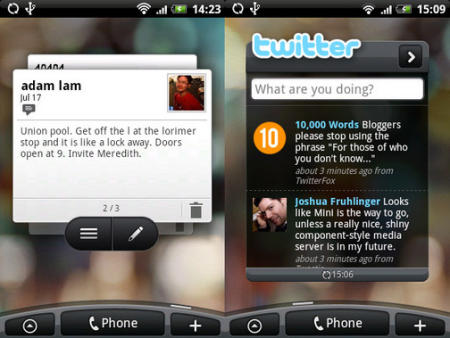
What you get in addition to the Android marketplace, though, is a plethora of new widgets and apps that HTC has developed specifically for the Hero’s Sense UI.
For business users, the most important addition will be an Exchange client. Yes, Microsofties, the HTC Hero can access Microsoft Exchange accounts natively, letting you see your works email if you’re using Outlook, as well as your GMail.
For example, it’s developed its own Twitter client, which it calls Peep, that exists both on the homepage and as a full-scale application. The widget is pretty basic, but the app itself is extremely functional and well thought out.
There’s a messaging widget that lets you create and read text messages very effectively, and shows them off in a visually pleasing way with some nice 3D transitions.
There’s also a neat widget called Footprints, which lets you GeoTag your photos, and then lets you subsequently sort your photos according to location and type.
For example, you can take photos of interesting-looking restaurants that you happen to pass by on your travel. If you want to find them again later, a search for restaurants will show you pictures and their actual location.
This is a great idea, and one I’d often use. I frequently go off travelling to external sites for work, and often pass really beautiful looking country pubs. I often think I’d love to check the pubs out at the weekend, but come the weekend, I can’t actually remember where they are!
With Footprints, this would be solved at a stroke.
Combine this feature with Android’s ability to know where it is in time, space, orientation, where it’s pointing in any 3D axis, and how fast it’s moving, and it’s clear that the Hero shines through as far as mobility and location-centred features are concerned.
HTC Hero reviews across the Web
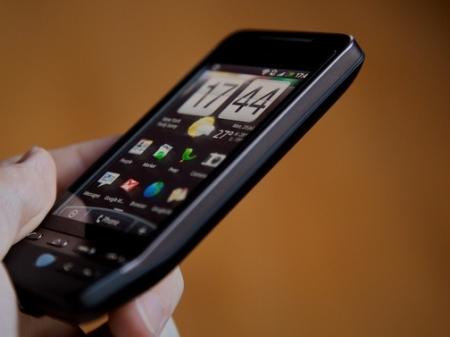
You might have noticed a pattern forming by now. Android is a great mobile operating system; HTC has made it look beautiful with the new Sense UI they’ve put on the Hero; but the end result is that all that new UI gloss has slowed the Hero down a fair bit.
Hmm, can you guess what the reviews across the Web say about it?!
Engadget kick things off with their HTC Hero review:
“[t]he Hero represents a valiant effort from HTC — though unfortunately, the company appears to have bitten off more than its last-generation hardware can chew. If this build of Android were to be loaded atop the guts of a 3GS or Pre, the performance would likely be astounding, but fused with the two-year old architecture of previous devices, it’s mostly disappointing…HTC has an explosive entry in the smartphone category with what its done on the software side… now it just needs the hardware to match.”
BoyGenius contines this theme:
“Would I take it over the Palm Pre? One hundred percent yes. The HTC Hero effectively crushed any hopes Palm had at keeping any sort of momentum (at least in my view). Though what I’ve found, sadly, is I get more enjoyment out of using my HTC Magic or the T-Mobile myTouch 3G than I do with the Hero. Like I said, HTC’s achievements and innovations aren’t anything to dismiss, they are what to me makes Android usable, but with the current hardware powering the HTC Hero, things become murky and frustrating.”
TechRadar are more positive, though with a familiar caveat:
“There’s a lot to like about the HTC Hero. A lot. Be it the multiple homescreens, the option to change scenes to suit the time of day, the Facebook integration or even the responsive touchscreen. It’s clear this is the best Android phone yet…But in terms of overall slickness, it still ain’t an iPhone.”
SlashGear are even more positive:
“HTC’s dedication to developing Sense and treating UI as a long-haul process rather than a short-term prettification exercise gives us hope that the few shortfalls and omissions we’re currently seeing in version one of the Hero will be addressed over time. It’s reassuring to know that not only is the Hero a great smartphone but that it’s only likely to get better as HTC continue their tweaks. It’s safe to say that, in the HTC Hero, Android has come of age.”
Gizmodo love the Hero, but they too point out its performance shortcomings. They write:
“The Hero is a really good phone. It might even be a great phone. HTC’s done a fairly remarkable job transforming Android’s rough surface into something slick and glossy and palatable while integrating social networking features that go beyond any phone but the Pre…The biggest drag on the phone is that it, well, drags way too often, smooshing the other solid user experience into a goopy ooze of the awesome sauce that you hoped the Hero would be…That said, the Hero is still the best Android phone yet. The phone’s design, revamped interface and features…make it a real alternative to the iPhone and Pre.”
Update: As a final note, the HTC Hero has won awards as the mobile phone of the year from T3, Stuff, WhatMobile and MobileChoice.
Conclusion
The HTC Hero is, without doubt, the best Android phone on the market today. It’s user interface is leagues ahead of other Android phones, and in terms of looks, is as good as the iPhone’s and the Palm Pre’s.
It’s only drawback is its overall responsiveness. Due to its gorgeous good looks it is slower than some other Android phones. Whether this is enough to put you off will depend entirely on what you want to use the Hero for:
- If you’re the type of person who has to have the sexiest gadget and want to visually outdo your iPhone-totting friends, buy a Hero.
- If you want a gorgeous looking multi-touch smartphone, you don’t do much typing, and you can live with a bit of lag, buy a Hero.
- If, however, you’re like me and use your smartphone for a lot of typing then don’t buy a Hero – wait for one of its more powerful brothers, or buy a G1!
I give the HTC Hero a 9/10.
Update: The Hero has now been significantly reduced in price in time for Christmas 2009. You can buy a Hero now for free from just £25 a month.
[Review and images from Gizmodo, Engadget, BoyGeniusReport, TechRadar and SlashGear]

